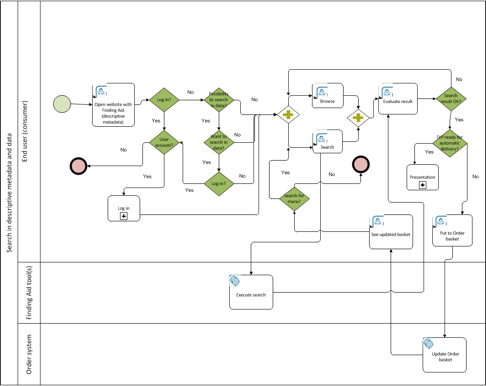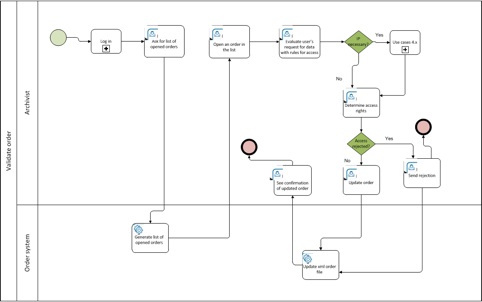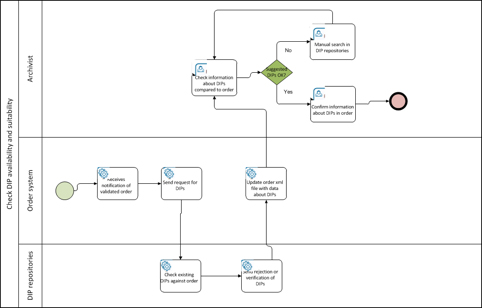Use Case 1.1: Search & Select records
This use case was used to illustrate how an end-user could get information about archival records. The search can be run by using the Archive’s Finding Aid or an EARK‐tool. It is the local Archive’s policy that determines when a user is required to log in, but it will probably be required from the moment an end-user wants to search data. The 'order' basket is well known from web-shops, but it has low priority here. The use case ends when the user has identified desired information objects or an item which can be automatically accessed. No order creation is needed in the latter case.
Search in descriptive metadata and data

Use Case 1.2
This use case starts when the end-user has identified the IPs with the required information and the IP cannot be accessed automatically from the Search tool / Finding Aid. This use case illustrated a process with an 'order basket' similar to a web shop, but this has low priority. Instead, the end-user can be asked to complete an order form with data about the user, IP and special requests. The most important part of this use case is the output: an xml-file (order.xml) with all data necessary to process the order.
Search in descriptive metadata and data

Use Case 1.2.2: Manage Order (Validate Order)
This use case starts when an order has been submitted from an end-user to the archive. The main purpose is to evaluate the user’s access rights. It is difficult to outline a generic process and to automate it because national legislations and Archives’ policies differ. It is assumed that this process is succeeded by the process “Prepare DIP”, but it can just as well be the other way round; or the processes may occur simultaneously.
The main point is that the xml-file with order data is updated with the user’s authorization to access the ordered IP(s)
Validate Order

Use Case 1.2.1: Manage Order (Issue Order)
This use case was used to illustrate an example of an end-user wanting to identify where (and how) they could get information about archival records. The search can be run by using the Archive’s Finding Aid or an E-ARK-tool.
It is the local Archive’s policy that determines when a user is required to log in, but it will probably be required from the moment an end-user wants to search data. The 'order basket' is well known from web-shops, but it has low priority here. The use case ends when the user has identified desired information objects or an item which can be automatically accessed. No order creation is needed in the latter case.
Issue Order

Use case 2.2: Check DIP availability and suitability
This use case starts when an order has been submitted from an end-user to the archive, and the main purpose is to check if an appropriate DIP already exists. It is assumed that this process is preceded by the ‘Validate Order’ process, but it can just as well be the other way round; or the processes may occur simultaneously.
The process may be automated to a certain degree. It depends on archival policies, local repositories, the level of access to these, the correctness and level of detail in the end-user’s order, and on the complexity of the ordered DIPs.
Check DIP availability and suitability

Latest News
-
E-ARK Rated "Excellent" by the EC - "A European Showcase Project"
03-04-2017
The European Commission's Year 3 Review of the E-ARK Project has rated it as "Excellent" and have...
-
E-ARK Year 3 Summary Report Published
16-03-2017
The E-ARK summary report of project activities in the final year of the project can be downloaded by...
-
E-ARK Report on Pilots
13-02-2017
E-ARK Project Report on Pilots The E-ARK Project final report on the pilots describes the...
-
DLM Forum announces the launch of the DAS Board
02-02-2017
The DLM Forum have formally launched the Digital Archiving Standards Board (DAS Board). The main...
-
E-ARK Project Completes its Reseach Phase
02-02-2017
The E-ARK Project has now reached the end of its Research Phase On 31 January 2017, after 3 years, the...
@EARKProject on Twitter
For the latest EARK news follow us on Twitter @EARKProject




















